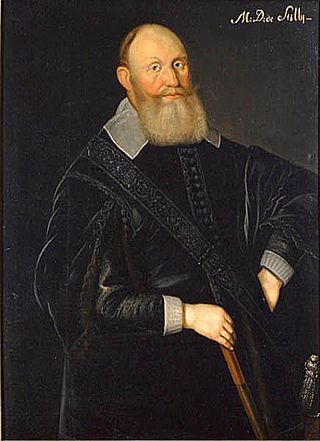Related Research Articles

Eric XIV was King of Sweden from 1560 until he was captured in a rebellion led by his brother John in 1568 and formally deposed 26 January 1569. Eric XIV was the eldest son of Gustav I (1496–1560) and Catherine of Saxe-Lauenburg (1513–1535). He was also ruler of Estonia, after it placed itself under Swedish protection in 1561.

John III was King of Sweden from 1569 until his death. He was the son of King Gustav I of Sweden and his second wife Margaret Leijonhufvud. He was also, quite autonomously, the ruler of Finland, as Duke John from 1556 to 1563. In 1581 he assumed also the title Grand Prince of Finland. He attained the Swedish throne after a rebellion against his half-brother Eric XIV. He is mainly remembered for his attempts to close the gap between the newly established Lutheran Church of Sweden and the Catholic Church, as well as his conflict with and murder of his brother.

Karin Månsdotter was first a mistress of King Eric XIV of Sweden and then briefly queen as his wife.

Catherine Jagiellon was a Polish princess and Queen of Sweden as the first wife of King John III. As such, she was also Duchess of Finland (1562–1583) and Grand Princess of Finland (1581–1583). Catherine had significant influence over state affairs during the reign of her spouse. She negotiated with the pope to introduce Counter-Reformation in Sweden. She was the mother of the future Sigismund III Vasa, King of Poland.

Cecilia of Sweden, was Princess of Sweden as the daughter of King Gustav I and his second wife, Margaret Leijonhufvud, and Margravine of Baden-Rodemachern as the wife of Christopher II, Margrave of Baden-Rodemachern. She is the most famous daughter of Gustav I, known for a courtship scandal in connection with a sister's wedding and for a lengthy stay in England under Elizabeth I where her first child was born.

Sophia Magdalena of Denmark was Queen of Sweden from 1771 to 1792 as the wife of King Gustav III.

Christina of Denmark was a Danish princess, the younger surviving daughter of King Christian II of Denmark and Norway and Isabella of Austria. By her two marriages, she became Duchess of Milan, then Duchess of Lorraine. She served as the regent of Lorraine from 1545 to 1552 during the minority of her son. She was also a claimant to the thrones of Denmark, Norway and Sweden in 1561–1590 and was sovereign Lady of Tortona in 1578–1584.

Catherine of Sweden was a Swedish princess and a Countess Palatine of Zweibrücken as the consort of her second cousin John Casimir of Palatinate-Zweibrücken. She is known as the periodical foster-mother of Queen Christina of Sweden and the mother of Charles X of Sweden.

Baron Pontus De la Gardie was a French nobleman and a general in the service of Denmark and Sweden.

Princess Elizabeth of Sweden, was a Swedish princess, and a duchess consort of Mecklenburg-Gadebusch by marriage to Christopher, Duke of Mecklenburg-Gadebusch. She was a daughter of King Gustav I of Sweden and his second spouse, Queen Margaret.

Princess Anna of Sweden, also known as Anna Maria and Anne Marie, was a Countess Palatine consort of Veldenz by marriage to George John I, Count Palatine of Veldenz. She served as Interim Regent from 1592 to 1598, and supervised the partition of the territories between her sons. She was the daughter of King Gustav I of Sweden and Queen Margaret.

Events from the year 1574 in Sweden
Anna Klemetsdotter Hogenskild (1513-1590), also known as fru Anna till Åkerö and fru Anna till Hedensö, was a Swedish court official and landowner. She served as hovmästarinna to queen Catherine Stenbock of Sweden, and then to the daughter and sisters of Eric XIV of Sweden.
Charles Dançay (1510–1589), was a French diplomat, the envoy of France to Denmark and Sweden from the reign of Henry II of France onward.

Hogenskild Bielke was a Swedish baron, court official and riksråd. He was one of the more prominent leaders of the Swedish nobility in their power struggle against royal authority during the 16th-century.
Gustaf Brahe was a Swedish riksråd and a Polish Field marshal.
The Mornay plot was a plot in 1574 to assassinate John III of Sweden, free the imprisoned Eric XIV of Sweden and place him or Charles IX of Sweden upon the Swedish throne. The plot was hatched and planned by Charles de Mornay, a Swedish courtier of French Huguenot origin with international contacts. It was one of three major plots to free the imprisoned Eric XIV, preceded by the 1569 Plot and succeeded by the 1576 Plot.
The 1569 Plot was a conspiracy in Sweden in 1569. The purpose was to depose John III of Sweden and reinstate the imprisoned Eric XIV of Sweden on the Swedish throne. The plot was instigated by the courtiers of Eric's spouse queen Karin Månsdotter; her lady-in-waiting Elin Andersdotter and her personal secretary Thomas Jakobsson. It was the first of three major plots to free the imprisoned Eric XIV, but has been described as the most serious one. The plot was exposed and prevented before it could be put in action and resulted in the execution of the conspirators.
The 1576 Plot was a conspiracy in Sweden in 1576. The purpose was to depose John III of Sweden and reinstate the imprisoned Eric XIV of Sweden on the Swedish throne. It was the last of three major plots to free the imprisoned Eric XIV, and was preceded by the 1569 Plot and the 1574 Mornay Plot.
Jean Allard or Jehan Alard, was a French adventurer.
References
- Ingvar Andersson: Charles de Mornay i Svenskt biografiskt lexikon (1945)
You can help expand this article with text translated from the corresponding article in Swedish. (December 2017)Click [show] for important translation instructions.
|